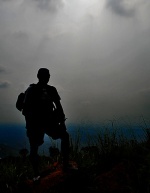Romblon: A beachgoer’s Paradise
May 15, 2019 Leave a comment
Sharing its name with the province, the town of Romblon is a picturesque settlement that gained prominence during Spanish colonial times as a trading post. The island municipality is blessed with natural playgrounds such as beaches, rivers, natural pools and diverse marine ecosystems that offer visitors several opportunities for adventures.
Agpanabat Marine Sanctuary
Romblon has 17 marine sanctuaries, the most popular being Agpanabat Marine Sanctuary and Turtle Rescue Center, just below Apunan Lighthouse.

Various species of corals and anemones cover the seabed and serve as home to colorful schools of fish.
Bonbon Beach and Sandbar
Perhaps the most popular beach destination in Romblon is Bonbon Beach. Just 15 minutes away from the town proper, this marble-white beach is Romblon’s top tourist drawer.

Tiamban Beach
Tiamban Beach is bounded by Nonok Beach and Bonbon Beach on either side, and is a good alternative when the two becomes overly crowded. The idyllic coastline of Tiamban Beach makes for a leisurely getaway.

Bang-og Islet can be seen here.
Nonok Beach
Nonok Beach is a favorite events place among locals. Its main attraction are its various underwater sculptures. You can rent a kayak and paddle your way around Nonok Beach’s mini mangrove forest.

Talipasak Beach
Thirty minutes from Romblon town proper in Talipasak Beach is San Pedro Beach Resort. This privately owned resort is a welcome change from the usually crowded Nonok, Tiamban and Bonbon beaches. One can just sit back and enjoy the view or take a dive and marvel at the diverse marine life.

Libtong Falls and Natural Pool
Off the beaten track, Libtong Falls features a natural pool walled in by bedrocks, best for a refreshing dip. While the falls is not that spectacular, Libtong is a popular destination for thrill seekers wanting to hone their cliff jumping stunts… or, as in our case, just chillaxing and cooling off after a 15-minute trek.


Quipot (or Kipot) River
Twenty minutes downhill from the main highway is Quipot (or Kipot) River. Kipot falls is also a favorite among those who subscribe to the thrills of cliff jumping.
















































 Mid 2014. I got a call from a friend who works at the Davao City Tourism Office that they’ve just recently visited Cateel, and that efforts to “restore” Aliwagwag Falls is “well underway”. The news got me excited–and sad at the same time, because I wouldn’t be seeing the falls in all her natural splendor. Nevertheless, that didn’t dampen my desire to visit Aliwagwag a single bit.
Mid 2014. I got a call from a friend who works at the Davao City Tourism Office that they’ve just recently visited Cateel, and that efforts to “restore” Aliwagwag Falls is “well underway”. The news got me excited–and sad at the same time, because I wouldn’t be seeing the falls in all her natural splendor. Nevertheless, that didn’t dampen my desire to visit Aliwagwag a single bit.









 There are two routes leading to Aliwagwag Falls: through Compostela Valley (which we took) and via Mati, Davao Oriental. The latter is the more practical option, as there are many trips going to Mati (via Bachelor Bus Lines), compared with only one trip (via Mallen Express) if going by way of Compostela Valley. Travel time varies from 6hrs to 8hrs.
There are two routes leading to Aliwagwag Falls: through Compostela Valley (which we took) and via Mati, Davao Oriental. The latter is the more practical option, as there are many trips going to Mati (via Bachelor Bus Lines), compared with only one trip (via Mallen Express) if going by way of Compostela Valley. Travel time varies from 6hrs to 8hrs.



















Jomalig Island: May You Always
February 25, 2016 Leave a comment
Sunrise at Salibungot Beach
The golden sands of Jomalig Island, punctuated only by a set of footprints that abruptly disappeared as the waves reclaimed its real estate…
So goes the song. I dunno why this tune, which actually was one of my high school graduation songs, floated into my consciousness as I was walking along the far corner of Salibungot Beach in Jomalig Island, Quezon.
Maybe, it’s the serenity of the place which transported me to my most favorite phase in my life: adolescence.
It was a time of discovery. Of adventure. Of learning.
A time where innocence gave way to rude awakenings. Restraint to carelessness. Fortitude to self-doubt.
Ah! The purity of youth… a time long gone. Forgotten. Abandoned. Something I would never wish upon this virgin paradise.
Jomalig…
May your sands remain unsoiled,
Your waters untapped,
Your pine trees unbent,
And your people unencumbered and good-hearted.
Share this:
Filed under Nature, Photography, Travel Tagged with beaches, commentary, diving, environmental awareness, island hopping, Jomalig, nature, Philippine destinations, Philippines, photography, photos, Polilio, protect our marine life, save our seas, SOS, tourism, travel, voluntourism